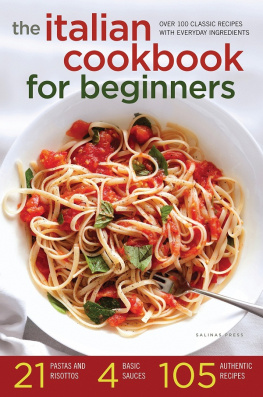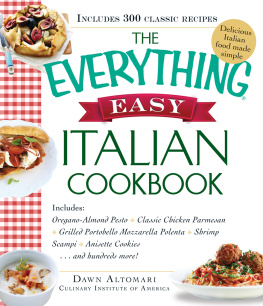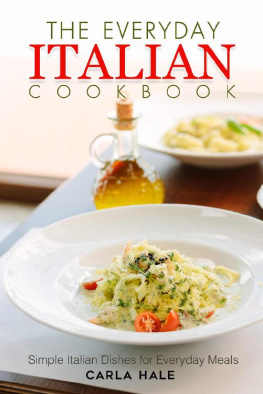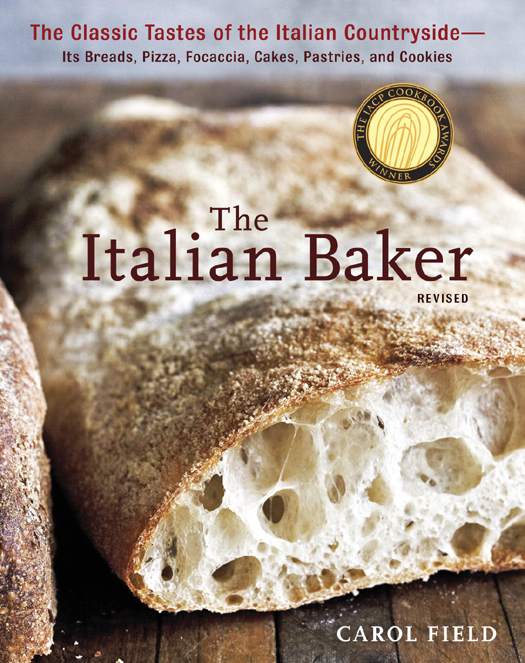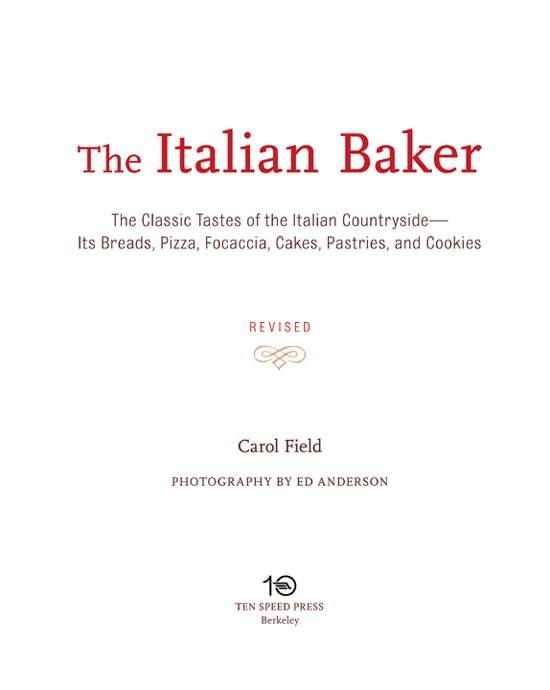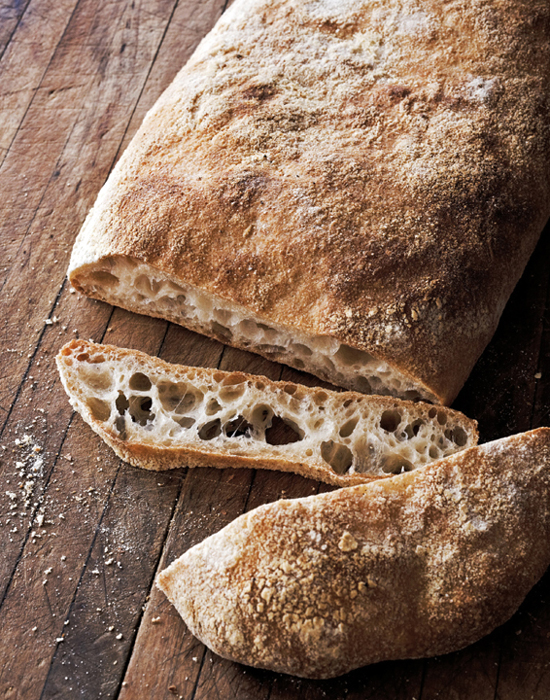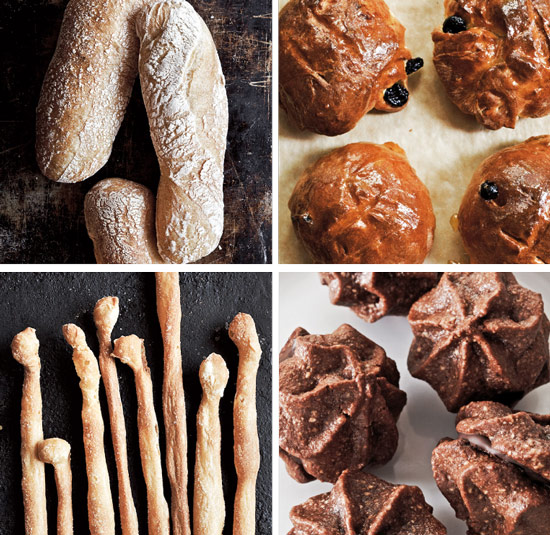Copyright 1985, 2011 by Carol Field.
Photographs copyright 2011 by Ed Anderson
All rights reserved. Published in the United States by Ten Speed Press, an imprint of the Crown Publishing Group, a division of Random House, Inc., New York.
www.crownpublishing.com
www.tenspeed.com
Ten Speed Press and the Ten Speed Press colophon are registered trademarks of Random House, Inc.
Originally published in somewhat different form by Harper & Row Publishers, Inc., New York, in 1985.
Library of Congress Cataloging in Publication
Field, Carol.
The Italian baker : the classic tastes of the Italian countrysideits breads, pizza, focaccia, cakes, pastries, and cookies / Carol Field ; photography by Ed Anderson. 1st rev. ed.
p. cm.
Includes index.
1. BakingItaly. 2. BreadItaly. 3. PastryItaly. 4. Cooking, Italian. 5. Cookbooks. I. Title.
TX763.F53 2011
641.5945dc23
2011017004
eISBN: 978-1-60774-107-7
v3.1
This book is for John, who has eaten it all.

CONTENTS

Pani Regionali e Rustici
REGIONAL AND RUSTIC BREADS
Pani Moderni
MODERN BREADS
Gli Avanzi
USING LEFTOVER BREADS
Pani Festivi
CELEBRATION BREADS
Panini e Grissini
ROLLS AND BREADSTICKS
Pizze e Focacce
PIZZAS AND FOCACCIAS
Pani Raffinati
ELEGANT BREADS
Crostate
TARTS
Torte
CAKES
Biscotti
COOKIES

W hen Don Abbacchio came to the reading of the gospel, he turned to us and preached us a little sermon about San Giuseppe da Copertino. We knew the story, but we always liked hearing it again. For this saint was a cafone who became a monk but never managed to learn Latin, and whenever the other monks recited the Psalms, he gave praise to Our Lady by turning somersaults wherever he might be, even in church. Our Lady must have been delighted with the innocent spectacle, and to encourage and reward him she gave him the gift of levitation, and after that he had no difficulty in somersaulting all the way up to the ceiling. He died at an advanced age, after a life of severe privations, and it is said that when he appeared before the heavenly throne, God, who knew him by repute and wished him well, because Our Lady had talked about him so often, embraced him and said, I will give you whatever you want. Dont be afraid to ask for whatever you like.
The poor saint was utterly bewildered by this offer.
May I ask for anything? he asked timidly.
You may ask for anything, the Almighty encouraged him. I give the orders here. I can do whatever I like here. And I am really fond of you. Whatever you ask for will be granted.
But San Giuseppe da Copertino did not dare confess what he really wanted. He feared that his immoderate wish might arouse the Lord to anger. Only after much insistence on the Lords part, only after He gave His word of honor that He would not be angry, did the saint confess what he most wanted.
O Lord, he said, a big piece of white bread. [For the only white bread he had ever seen was in Jesus hand in a painting on the church altar.]
And the Lord was as good as His word and did not grow angry, but embraced the cafone saint, and was moved and wept with him. And then, in His voice of thunder, He summoned twelve angels and gave orders that every day from morning till evening for all eternity, per omnia saecula saeculorum, they should give San Giuseppe da Copertino the best white bread that was baked in paradise.
Ignazio Silone, Fontamara

ACKNOWLEDGMENTS
T his book owes an enormous debt to so many people, both in Italy and in America. It wouldnt even exist without Carlo Veggetti, who so generously shared his formidable knowledge of Italian baking and introduced me to bakers all over Italy. For this edition he persuaded several of them to bake the many specialties that illustrate the book in its new incarnation. And of course it owes everything to the bakers themselves. Special thanks are due to Renato Veggetti, whose generous spirit and helpfulness were endlessly tested by my requests and questions. Renato was patient and kind to an incredible degree.
I couldnt even have written this book without the boundless help of Diane Dexter, who assisted me from beginning to end. Her knowledge of baking and her extraordinary patience as we tested recipes over and over again kept me going. I dont think I could have faced so many go-arounds if Diane hadnt been as curious and as willing to keep searching for solutions as I was.
When I met Joann Carmody, she was a young baker at Il Fornaio in San Francisco who had gone to Italy to bake in Florence and Venice because she wanted to know how things were done there. She was an invaluable help, not only sharing her knowledge but actually traveling to Italy with me for her entire vacation and baking alongside the pastry bakers.
In America, numerous friends have tasted and tested these recipes. Joyce Goldstein, then the chef at the Caf at Chez Panisse, came to taste as often as she could, and she was so pleased with what she found that she served several of the rustic breads at Square One, her restaurant in San Francisco. Her encouragement and help meant an enormous amount to me. Carol Sinton, Maxine Bloom, Marjorie Traub, Pat Berkowitz, and Leslie Freudenheim tested for me and gave me wonderful feedback. Paola Bagnatori was spectacularly helpful, tasting much that I made and even seeing bakers for me when she was in Italy, to help get answers that I needed. Francesca Vattani not only brought back special sweets from Venice, but she helped me in Italy as well, and she and Alessandro were fabulously encouraging to this non-Italian admirer of their countrys heritage. My father, James Hart, brought me books that I needed and discovered that he loved Italian bread after all. Other special help came from Joanne Hayes, a young baker; from Holly Pugliese, who provided baking help in this current edition; from Barbara Winkelstein, who parted with her wonderful panforte recipe; from Bob and Maggie Klein; from Fred Hill; from Amanda Pope and Celeste Gainey; from Rose Scherini; from numerous Italians living in America who shared memories with me, but especially from Elisabetta Nelsen and Eugenio Pozzolini, who remembered so much of their Tuscan childhoods and the role that bread played in them; and from Loni Kuhn and Carlo Middione, who tasted my breads and discussed them with me.
In Italy, I dont know what I would have done without the friendship of Shirley and Franois Caracciolo in Todi and Rome, and of Gianna and Riccardo Bertelli in Tuscany. John Meis at Badia a Coltibuono, in Gaiole in Chianti, and Maria Caterina and Franco Crespi in Perugia, were wonderful sources of information and help. Silene Veggetti and the childrenMattia, Stefania, Alfonso, and Giuliawere wonderfully helpful and hospitable during my stays in Italy years ago, and for this edition, Silene and Moira Marelli were invaluable in coordinating the bakers with the photographers visits. I am very grateful to Claire Hennessy for helping the photographer for this edition. Thank you to Faith Willinger for helping me find her. Thanks to Bonnie Nadell who stepped in when I really needed her. Christian Hansen and Adolfo Veggetti are two others to whom I am very grateful for much help. Nando Tosoni baked in Rome but answered questions for me and baked in San Francisco as well, and Agostino Di Vella was a wonderful guide to the breads and sights of Altamura and Matera. Nella Galetti showed me old-fashioned ways of baking at home.


